I was given this machine to repair & restore – a National Electric watch cleaning machine Model 1 which dates from the 1940’s. It was in a very poor condition, rusty and all electrical parts visibly corroded and the original fabric insulation on the wiring had rotten.
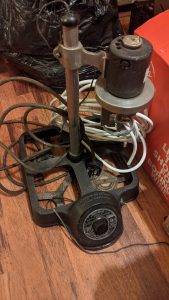
This was a very dangerous machine even when new; they didn’t care much for electrical safety in them days! If you turned it over all the live wiring was accessible as was the rheostat which controlled the motor speed. Simply picking it up whilst plugged in could have resulted in an electric shock. Also the heating element, directly connected to the mains had a jar sat on top of it full of water which is splashed about with an impeller.
I decided that in order to make this thing somewhat safer it would need to be re-wired and some sort of plate fastened over the base to cover the exposed live parts. However upon further inspection I deemed it too unsafe to even plug in so I didn’t bother testing it with power applied. I tested all the parts individually and found that the motor had burnt out with it visibly heavily water damaged and rusted, the power switch was open circuit even in both positions, the rheostat was visibly corroded and the heating element was busted. In short every component on it was faulty with nothing salvageable or repairable at all. It was questionable what I would be able to do with it given the lack of parts, tools and a decent work area as this had to be done on the kitchen worktop.
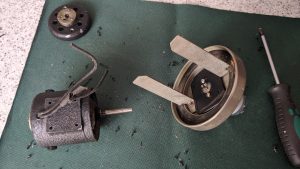
Now this really is just scrap at this point as it couldn’t be any more broken but cost of a new machine was too prohibitive so I decided to replace it all with low voltage parts. The motor was sourced from a HP officejet 6500A which previously served as the carriage motor and despite it’s small size was quite powerful. The motor shaft was a non standard 3.4mm diameter so I had to purchase a 3mm to 6mm coupling and then bore out the 3mm hole to 3.4mm. This was done on a lathe to ensure it was exactly straight to avoid wobble. Next problem was that the impeller bore was not metric with it being some size between 6 and 7mm so a 6mm metal rod was used to fasten it to the coupling and sellotape to pack out the protruding end to the same size as the bore. This was then fixed in place with two grub screws 180 degrees apart so any small amounts of wobble could be adjusted.
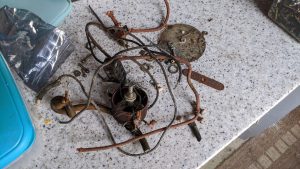
The replacement motor was small enough to fit inside the old motor casing once it had been gutted of the burnt out stator and windings. Some of the brush housings had to be grinded away with a dremel too. The motor was then fastened to the original plate so that any mounting brackets would be unnecessary. When it was tested there was a very small amount of wobble and vibration but after adjustment it was reduced to an acceptable level. To adjust speed I used a XL4016 based voltage regulator from Amazon to adjust the voltage between 2 and 11.5V and this was fastened to the front panel using a block of wood.
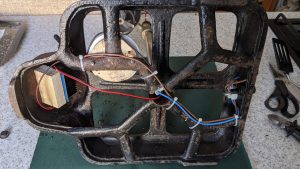
With that problem taken care of all I needed to do was replace the switch and the element. I used a 80 degree 12V PTC heater plate again from Amazon fastened to a plastic plate that was then fitted on top of the existing ceramic insulator. This may not work very well as there isn’t much of the heater plate in contact with the jar base. Replacing the plastic plate with a steel or aluminium plate and mounting it upside down would be better. However rather than go to this expense, I will try it as-is and if it does not heat well I will change the plastic plate for metal. Finally the machine was powered from a standard 12V 5A CCTV power supply as the peak current is only 4 amps. This enables the power supply to be easily replaced in the event of it going faulty.
The machine will be given back to its owner and if any further modifications are required I will update this article.
Here’s the finished item which is just waiting for a control knob to be fitted to the voltage regulator control pot.
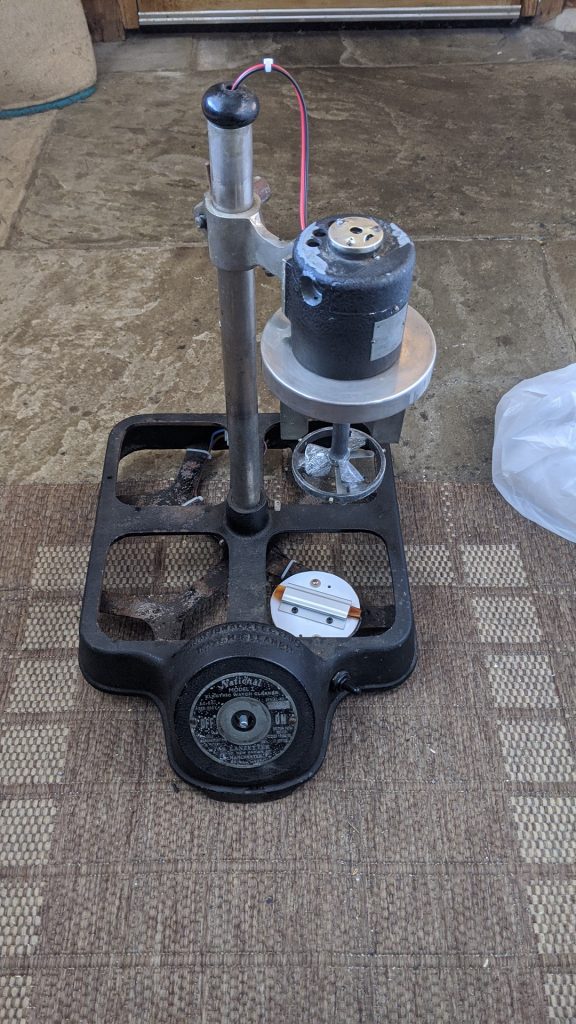
Hi Adrian, where a you based? I have National Major watch cleaning machine that needs the wiring looking at. Would you be interested in having a look at it? Thanks, Ian Flavell
I’m based near Bradford, West Yorkshire. Does the machine work otherwise? The ones I worked on I have converted to 12/24V; they were slightly different models and the second one I fitted a replacement control panel to keep the wiring and electronics out of the way of water and cleaning chemicals. Both had faulty motors, one had a working heating element but it was dangerous as live element was exposed to water. It wouldn’t meet modern safety standards and had to be replaced. If you have any photos that would be great.
Also I’m waiting for the owner to get back to me regarding if the heating element I fitted was good enough. With lockdown restrictions he hasn’t had chance to try it yet.
If you are interested in the extensive repair of the second one I did here is a video of it showing what it looked like afterwards. It was in a very poor condition and missing parts that had to be replaced. I used a soil pipe cover for the jar cover and motor bracket. https://www.youtube.com/watch?v=dEc9o9dufz8
Hi Ian,
if your interested in selling this as it is I would be interested
My email is cysgod@live.com
Thanks Mike
Hi Adrian
I wonder if you can help! I have a similar machine by Brenray.
Do you have some kind of wiring diagram?
Trying to get into work.
Many thanks
Kevin
Hi, there’s no wiring diagram but there was a switch for the heating element and the motor controlled via a rheostat. I ripped it all out and converted to 24V using an electronic speed controller.
Hello Adrian, I am from Cape Town, South Africa and I recently acquired the exact same model in a similar condition. I’m not sure if the motor works, as I’ve not been able to test it due to the corroded wiring.
Just as a matter of interest; is this particular cleaner a collector’s piece? If yes, do you have any idea of its value?
Kind regards.
Yolanda
Hi I’ve seen them go for a few hundred pounds on eBay but they have to be in working order with all or most original accessories. I’m not sure if they are collectors items or not or what their value is.
There definitely seems to be a market for them though and value depends on condition. I saw one for £70 in a similar condition to the one I had as I was looking for parts when I was refurbishing it. I decided to replace the parts with modern ones which would have affected it’s value but it was / is being used in a repair shop so it had to be repaired asap.
Adrian